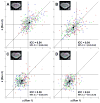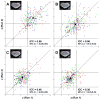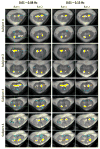Reproducibility of resting state spinal cord networks in healthy volunteers at 7 Tesla
- PMID: 26924285
- PMCID: PMC4889527
- DOI: 10.1016/j.neuroimage.2016.02.058
Reproducibility of resting state spinal cord networks in healthy volunteers at 7 Tesla
Abstract
We recently reported our findings of resting state functional connectivity in the human spinal cord: in a cohort of healthy volunteers we observed robust functional connectivity between left and right ventral (motor) horns and between left and right dorsal (sensory) horns (Barry et al., 2014). Building upon these results, we now quantify the within-subject reproducibility of bilateral motor and sensory networks (intraclass correlation coefficient=0.54-0.56) and explore the impact of including frequencies up to 0.13Hz. Our results suggest that frequencies above 0.08Hz may enhance the detectability of these resting state networks, which would be beneficial for practical studies of spinal cord functional connectivity.
Copyright © 2016 Elsevier Inc. All rights reserved.
Conflict of interest statement
The authors declare no competing financial interests.
Figures





References
-
- Biswal B, Yetkin FZ, Haughton VM, Hyde JS. Functional connectivity in the motor cortex of resting human brain using echo-planar MRI. Magn Reson Med. 1995;34:537–541. - PubMed
-
- Braun U, Plichta MM, Esslinger C, Sauer C, Haddad L, Grimm O, … Meyer-Lindenberg A. Test-retest reliability of resting-state connectivity network characteristics using fMRI and graph theoretical measures. Neuroimage. 2012;59:1404–1412. - PubMed
Publication types
MeSH terms
Grants and funding
LinkOut - more resources
Full Text Sources
Other Literature Sources
Medical

